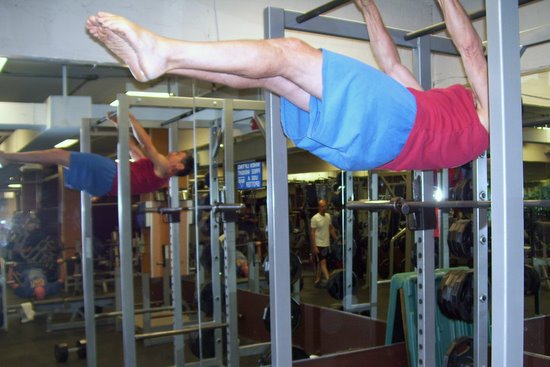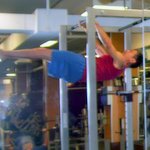Dragon Door Interviews Jack Arnow
by Adrienne Harvey PCCTL, RKCII, CK-FMS, Primal Move Nat'l Instructor

Dragon Door: How did you first get into bodyweight training?
Jack Arnow: When I was about 15 years old, a friend asked if I wanted to go to a chinning bar with him after school. At the time I hadn't ever really chinned before, but went anyway. At this particular chinning bar in a vacant lot, Jasper Benincasa—whose name you probably know—was working out. He put up several bars in Brooklyn. When we got there, we saw many people of all ages taking turns chinning. That's how I got started. I guess I liked it because I kept going back. It was on the way between school and my house, so everyday after school I’d stop by and chin. Sometimes I’d see Jasper and sometimes not.
I just kept chinning, and started getting better at it. It was a good fit for me because I didn’t weigh much and have an obsessive personality! I would just keep doing it even though I wasn’t good at it at first. I was a slow learner and still wasn't great at the more gymnastic moves, but I started to get really good at chinning, muscle-ups, and back levers which we called "back planks." Eventually I could do lots of chins and muscle-ups. I knew I was strong, and felt pretty good.
One day, Jasper suggested I try what he called "comedowns". They were something he invented—no one else was really doing them at the time. Basically they are what you might describe as "one-arm negatives". About a year later he surprised me by saying I should try a one-arm chin-up. I didn't have it as a goal at the time, and was just a kid, but I tried it just it for fun. At first I got stuck on the way up and he said, "Turn in." I sort of turned in towards the bar, as I do to this day with one-arm chins. The cue worked and I came right up. I felt so elated! Then he said, "Try one leftie!" I thought he was crazy because my right side was so much stronger. But I tried it and came up leftie too. Jasper said, "You’re a natural." At the time, I didn’t know what he meant by that, but I never forgot it.
Jasper was 22 years older than me and started chinning at age 4. His father had a store with racks of clothing, and he'd climb on the clothing racks. By the time he was 10, he was playing in the playgrounds. At some point, he decided to learn a one-arm chin, worked on that and eventually got it, though I'm not sure how long it took. The rest is history. He basically kept doing one-arm chin ups until his death.
Dragon Door: Have you been practicing bar calisthenics ever since you were 15?
Jack Arnow: I just kept practicing and practicing. I did my one-arm chins until about age 35, when I stopped for a while after having kids, but I have always exercised. I had a chinning bar at home and still chinned but stopped training for one-arm chins, because I was busy with life. I always did push ups and those kinds of exercises. At times I ran half marathons, and I played basketball fanatically for many years. I just liked moving and would obsessively practice whatever I was into. I wasn’t particularly good at these things, but I would stay with it, analyze what was wrong, then think about how to do it differently. Until my 50s, I played basketball in the park, but after I came home with a broken rib, my wife said, "You can’t do this anymore. You shouldn’t be playing with the kids!"
Dragon Door: How did you get back into bodyweight training and specifically one-arm chin-ups?
Jack Arnow: My mom was dying of cancer, and I was upset—so much that I was getting digestive problems, so I started exercising again. It always calmed and relaxed me. I started running and using the chinning bar in front of my house in Prospect Park. Soon, my goal was to do a one-arm chin again. I knew how to train for it from my youth, but learned more this time. Other people at the bar would interact with me, and we'd exchange general advice. I know details about one-arm chinning, and have trained many people to do just regular chins too. I shared what Jasper showed me, basically the "comedowns" (negatives) with two hands. I’ve trained people for one and two arm chins over the years, but most people are discouraged or lose interest when they find out how much time and dedication it takes to learn one-arm chins.
At age 50 I got my one-arm chin-up back at times. I had to think of different training methods because the old methods weren’t working. Sometimes I'd push myself too much—that’s why I said it took me 50 years to learn to take it easy in a comment on the Progressive Calisthenics Blog. Yoga also helped me learn patience.
Around age 60, I was doing one-arm chins again until I got elbow tendonitis. So, I took up yoga and nine months later, my shoulders and knees were better. Of course I started training again, and I got the one-arm chin back again! At age 65, my wife and all my friends wanted to know what I was trying to prove. So after meeting my goal of doing one-arm chins and front levers at Burning Man on a custom made chinning bar, I consciously decided to stop doing one-arm chin-ups for a little while.
Eventually, after training others to get their one-arm chin, I decided that I am smart and cautious enough now to train for it again. At an advanced age, it's very hard to work on these skills because it's even easier to get injured and takes so long to recover.
The Internet also inspired me. For a while I'd search for one-arm chin-up articles and wouldn't find anything. Eventually, I found an article about how to train for one-arm chinning. I read the article which was interesting, but I knew the writer couldn't do one-arm chins because he had written it from an outside perspective. I wrote to him and found out that his father was a one-arm chinner, from Jasper’s era.
Dragon Door: What inspired you to write your one-arm chin up article for Dragon Door?
Jack Arnow: I got such joy from doing one-arm chins since I was about 15 or 16 years old that I felt I had knowledge and experience to share from having done thousands of one-arm chins. From age 16 to about 35, I would do 3 sets a day for 4-5 days a week, and often did 16 alternate one-arm chins in a set—which comes out to about 50 reps a day for years. Most people will never do that many in their whole life. They may get a one-arm chin, and they'll probably lose it. Even if they have done more reps in a set than me, most people haven't been able to do this for years and years. I also wanted to share my experience and knowledge from training with Jasper.
At the time that I wrote the one-arm chin-up article, I didn’t have that much knowledge yet. I had recently learned some tips from Pavel's The Naked Warrior, although a lot of it I had already known and used intuitively. I thought The Naked Warrior was a genius book. I just got a copy of Convict Conditioning today from Paul Wade, and after just skimming it, I think I'll learn a lot from it too.
Dragon Door: When we talked before, you'd also mentioned teaching yoga.
Jack Arnow: I started practicing yoga at 60. During the first month I hurt my wrist and knees because I was overdoing it, but I slowly adjusted. I started to practice at home—I’m very disciplined, it's one of my super strengths. If I half-remember something, I'll try it at home. Even if I get it wrong I'll learn from it and at the next class I'll learn it better. I'm always encouraging other people to practice at home because it's convenient for every day practice.
When I first started yoga, I could barely move, but it was fun, so I just kept doing it anyway. After a few years, I decided to become a certified yoga teacher. I retired from fulltime teaching at the college so I would have time to complete the nine-month certification course. I wanted to learn this stuff. Through the certification course, I met a lot of different people and made many friends of all ages.
The yoga classes I teach are very unique. We use the principles of yoga, but I don’t usually follow the traditions. We don’t say Namaste or om or anything like that, but I'm a very active teacher in class. Many people really like the energy, thoughtfulness, and how every class is different. I try to make everybody succeed and feel good about themselves. It’s a way of healing people at a very deep level—it isn't just physical exercise. I’ve changed the view of what I’m trying to accomplish. I've changed my attitude of how I act toward my students. I'm not just teaching them math or chemistry or yoga but realized they might be talking to me because maybe they need someone to talk to. This has given me a broader view of my role in life.
I taught math and computer courses in a local community college for 26 years, but for the past 4 years I have been teaching chemistry, physics, and yoga at the college part-time. Before I started teaching, I was working for Chase bank—running the computer systems for foreign exchange trading. They actually made me a second vice president, but I quit because I always wanted to be a teacher. I love teaching, being in the classroom with all the interactions and challenges, and I like people so it’s fun.
I try to see what a student actually needs and sometimes change my plans to suit those needs. It's important to balance what's good for the class with what’s good for the individual, and to be flexible. I put a lot of energy into my teaching and make it personal.
 Read more from Jack Arnow: the One-Arm Chinning Guide and his recent Progressive Calisthenics Blog post, "Live and Learn."
Read more from Jack Arnow: the One-Arm Chinning Guide and his recent Progressive Calisthenics Blog post, "Live and Learn."
Back